In 2013, the American Medical Association defined obesity in humans as a disease. The veterinary medical profession is also pushing to have obesity in companion animals similarly designated. In October 2019, the Association for Pet Obesity Prevention (APOP) released a position statement (the “Global Pet Obesity Initiative”) calling for a uniform definition of obesity in companion animals, a universal body condition score system, and a definition of obesity as a disease. The release found wide support from veterinary healthcare organizations all over the world.
Chances are, if your dog is carrying extra pounds, she doesn’t feel good. The impact of even a little excess weight is exponentially greater and more concentrated in dogs than it is in humans. Canine obesity can not only cause a number of diseases and exacerbate others, but it also impairs normal body functions. Overweight dogs are predisposed to developing metabolic irregularities, abnormal functions in many organ systems, diabetes mellitus and insulin resistance, hypertension, diseases of the kidneys, liver, and skin, arthritis, bladder/urinary tract issues, joint and ligament problems and other orthopedic issues, thyroid imbalances, respiratory conditions, heart failure, and chronic inflammation.
Research has also demonstrated a connection between obesity and cancer, but it is not clear how it increases cancer risk. One theory is that excess fat around vital organs increases damaging inflammation. Over time, chronic low-level inflammation can cause DNA damage that leads to the development of cancer.
Dogs who are overweight or obese also live shorter lives – on average, 21/2 years less than dogs with a healthy body condition. A study published in 2018 examined records for more than 50,000 client-owned, neutered dogs across 12 popular breeds over a 20-year span and found that overweight body condition was associated with a shorter life span in all 12 breeds. The magnitude of the effect varied, being least for large-breed dogs (5 months) and greatest for dogs of the smallest breed (more than 2 years).
The good news is that a lot of these health concerns can be prevented, mitigated, or eliminated by proper nutrition, an active lifestyle, and maintaining a healthy weight.
MANY FACTORS AFFECT A DOG’S WEIGHT
Energy is measured in calories, and calories are essential for a body to function. Excess energy, however, is stored as body fat and occurs when more calories are consumed than are used by the body.
Fat storage can be a useful hedge against leaner times ahead for some animals. For example, bears spend their non-hibernating days searching for food and eating as much as possible so that this extra weight (stored energy) is available for the body to use for basic bodily functions while they hibernate. They do this because food is not readily available during the lean cold winter months. In hibernation, their bodies reduce their physiological processes to their most minimal level, using the stored energy to survive.
In contrast, our dogs have food available year round and therefore don’t have any need for storing extra energy. In fact, that extra weight can be detrimental.
Besides the amount of food, there are other factors that can affect the weight of a dog. Calorie density (the number of calories in a serving) and the digestibility of food can also play a role. Non-food related factors that can affect weight include genetics, lifestyle and activity level, stage of life, climate, and even some diseases.
In October 2019, Preventative Veterinary Medicine published a Danish study that looked for obesity risk factors.2 Researchers found that neutering increased the risk of obesity in male dogs, but females were at risk regardless of whether they were intact or spayed. Interestingly, as dogs aged, the study noted that the risk of obesity increased in older female dogs but decreased in senior males.
The same study found that owner behavior is an important factor in canine weight management. Overweight owners tended to give treats freely as a snack or when the owner is eating, whereas non-overweight owners usually dispensed treats for training purposes only. This suggests that the health of pets and owners is interconnected – and that weight management plans for both dog and owner might be more successful if they were jointly undertaken!
BODY CONDITION SCORE
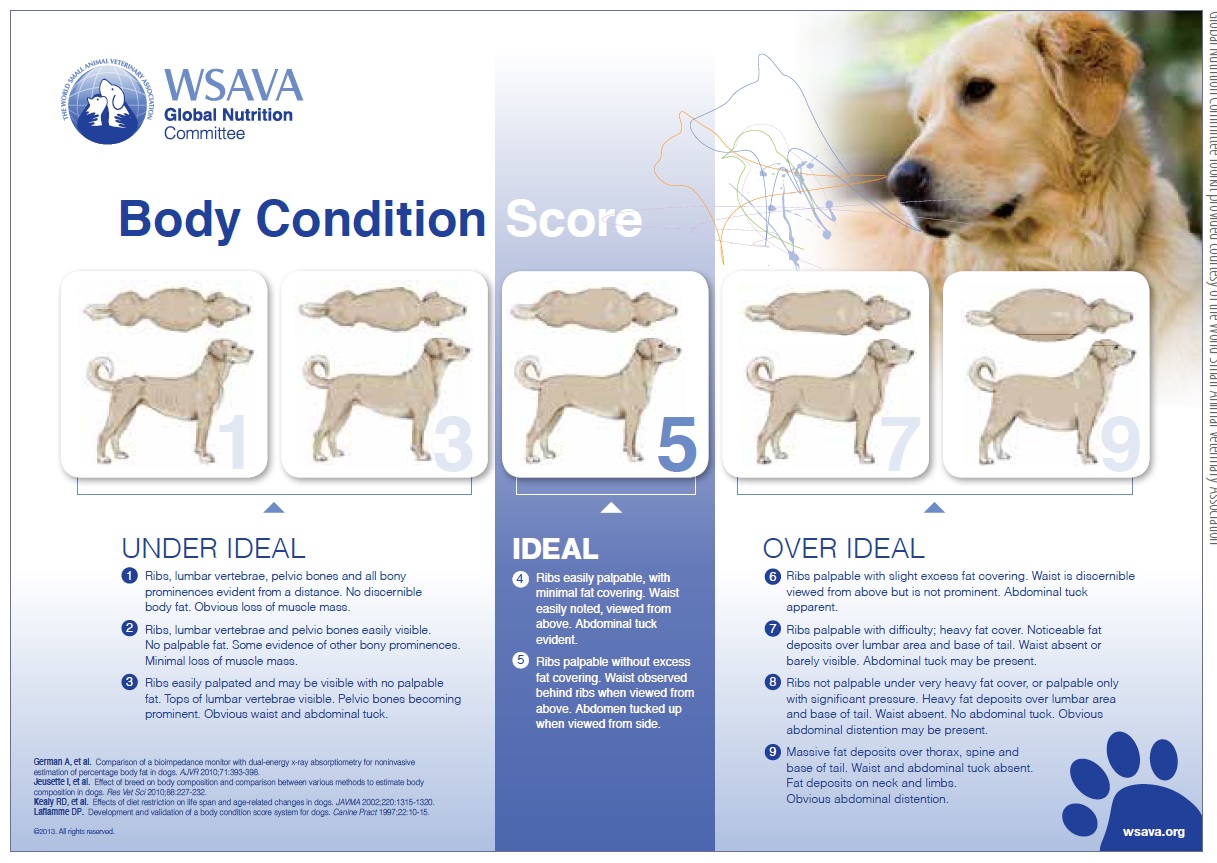
Because the ideal weight of a dog varies based on breed, size, and age, and the dog’s condition is more important than how much he weighs, a body condition score (BCS) provides for a more a meaningful measurement than the dog’s weight alone.
BCS guidelines call for an assessment of condition at certain locations on a dog’s body; these assessments can then be categorized into a score. The nine-point scale ranges from 1 to 9. A score of 1 indicates the dog is extremely thin, and score of 9 indicates extremely obese. Scores of 4 and 5 are considered ideal.
The difference between each point on the nine-point chart represents approximately 10 to 15%. Generally speaking, a dog is considered overweight when the level of excess body fat is greater than or equal to 15% of ideal; while obese is loosely defined as being 30% above optimal.
An overall BCS score gives an owner more information about what the dog’s whole body does look and feel like – and how, specifically, it should look and feel. While frequent weigh-ins are helpful for detecting small losses (or gains) in a dog’s weight, the BCS helps describe both the problem and the goal.
1. Measure food out in daily portions and use that food for treats as well as meals.
2. Never guess at amounts. Use a food scale.
3. Become familiar with the caloric measurements of your dog’s food.

4. Avoid processed treats; instead, seek out healthy single-ingredient treats (such as fresh vegetables and fruit) – and know how many calories they contain!
5. Use play, praise, petting (only in forms the dog enjoys), or attention instead of treats to reward good behavior.
6. Some dogs use food-seeking behavior as a way to seek attention. Try substituting play, petting, and other forms of interaction instead of giving in to that request for a snack.
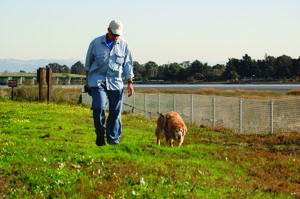
7. Walk with your dog. Slowly increase distance as your dog builds stamina.
8. Play with your dog! Look for toys that interest your dog and encourage movement.
9. If your dog gets bored with a toy, put it away to bring out at a later time and try a new one.
10. If your dog likes to play with other dogs, schedule play dates with appropriate play partners.
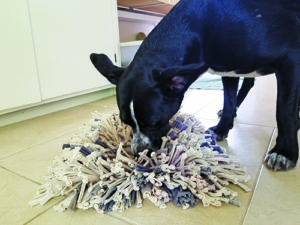
11. Place your dog’s food bowl in a different place at every meal; turn “going to find the bowl” into a “search and find” game.
12. Use a food-dispensing toy (like Paw 5’s “Wooly” snuffle mat, seen here) so that your dog gets exercise and enrichment while eating.
VETERINARY HELP REQUIRED
The first step to addressing your dog’s weight condition is a wellness visit to your veterinarian. If are finally facing the fact that your dog is obese, don’t put her on a weight-reduction program without veterinary input first; there may be an underlying health condition that is responsible for the excess weight. For example, hypothyroidism, hyperadrenocorticism, and Cushing’s disease can be associated with weight gain; these and other conditions must be ruled out as possible causes or contributors to your dog’s weight issue.
Your veterinarian should test for diabetes; obesity can complicate blood-sugar regulation. If your dog is diabetic, the condition needs to be stabilized prior to embarking on a new diet and monitored throughout the process so adjustments to medication can be made. If medications are not adjusted appropriately, it can lead to hypoglycemia, which can be fatal.
Your veterinarian can work with you to assess your dog’s body condition, muscle condition, and lifestyle, and evaluate any other concurrent health conditions that might need to be addressed in concert with the dog’s new diet and exercise plan.
Importantly, your vet will also calculate how many calories you should feed your dog each day. Few people seem to understand that the recommended feeding amounts on dog food labels are based on dogs’ ideal weight. They feed the amount indicated on the label for the dog’s current weight, which makes him get even fatter!
Ask your veterinarian to help determine what your dog’s ideal weight should be, how many calories your dog should eat to achieve that weight, and precisely how you should adjust from your current feeding regimen to a more appropriate amount. (Hint: If you cut your dog’s food in half overnight, you may see the quick emergence of unpleasant behaviors, such as counter-surfing, getting into the garbage, aggression with your other dogs over food, and so on.)
Your vet also may consult with or refer you to a board certified veterinary nutritionist to help determine the best feeding options for your dog. Diplomates of the American College of Veterinary Nutrition (ACVN) are extensively trained in the nutritional management of both healthy animals and those with diseases. These specialized veterinarians are uniquely qualified to formulate commercial foods and supplements, formulate home-prepared diets, manage the complex medical and nutritional needs of individual animals, and understand the underlying causes and implications of specific nutritional strategies that are used to prevent and treat diseases.
EXERCISE AND BEST DOG FOOD FOR WEIGHT LOSS
The three basic strategies to losing excess weight are reducing caloric intake, increasing exercise, and a combination of the two. Weight loss is usually best achieved by the latter.
Ideally, a dog’s weight-reduction program will be designed so that the dog receives enough calories to support his ideal weight, achieve weight loss, and keep him comfortable throughout the program. When his caloric intake is reduced to a more appropriate level (sufficient to support the energy needs of his ideal weight, but not enough to support his extra weight), his body will start to pull energy from the stored weight.
Low-calorie, fiber-rich foods (such as green vegetables) can be beneficial to the success of a weight loss plan; they not only help dogs feel fuller and reduce the sensation of hunger, they reduce the caloric density of a diet so that a larger volume of food can be fed.
When food needs to be reduced over prolonged periods, specialized diets may be prescribed to ensure that nutrition deficiencies do not occur. Good nutrition is necessary for maintaining optimal health and for managing certain diseases.
Exercise is important for general health, but that’s not the only reason it helps: Muscles burn more calories than body fat, and increasing exercise helps build muscle mass.
Work closely with your veterinarian to develop a safe and appropriate exercise plan, too. If your dog is not accustomed to exercise, do not begin with a vigorous new regimen as it can be dangerous. Slow and steady tends to work best, with increases as your dog becomes healthier.
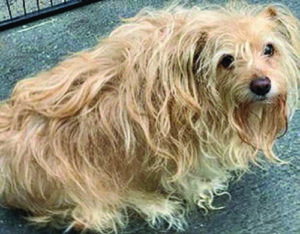
Kissy, a 9-year-old Scottish Terrier/Poodle-mix, entered the Dogwood Animal Rescue Project (DARP, a nonprofit, foster-based animal-rescue group located in Sonoma County, Calif.) in mid-April 2020. When she arrived, it was obvious that she had a lot of extra weight on her small frame; on the body condition score (BCS) scale, she scored at 9. She was so heavy she had difficulty walking – even stepping over a two-inch barrier was a challenge. It was also immediately apparent that she was aptly named: Jessica, her foster provider, describes her as a sweet, gentle girl who always wants to give kisses, but a little shy.
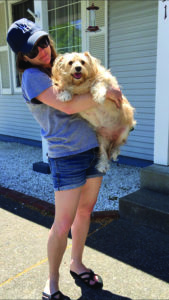
Kissy’s veterinary evaluation found she had dental disease, so she underwent cleaning with extractions. Jessica also noticed that Kissy was drinking an excessive amount of water and was lethargic; the vet determined that she had a urinary tract infection (UTI). Not long after she was started on antibiotics to treat the UTI, her energy level increased and her demeanor became much happier and more outgoing. It was impossible to determine if secondary health issues were causing Kissy’s obesity (the results of her Cushing’s test, for example, were inconclusive) or if the obesity was causing secondary disease. Either way, she needed to lose weight, so a veterinary-supervised program was put in place.
Kissy’s diet consists of precisely measured food given to her twice a day and periodic treats of carrots and green beans. Jessica started her on slow walks. At first, Kissy did not seem to understand what a walk was! With gentle training and encouragement from Jessica’s other two dogs, Kissy is discovering the joy of walking and is starting to sniff and take in the adventure.
In addition to her individual short walks – which are getting longer and longer as her health improves – Jessica includes her on more vigorous outings with her dogs by bringing Kissy along in a stroller. She’s easy going but doesn’t want to be left out of the fun! Jessica also found that Kissy loves to chase balls and that was initially part of her exercise routine. Unfortunately, Kissy was experiencing lameness in a rear leg and has been diagnosed with a torn anterior cruciate ligament (ACL). Until that can be resolved (possibly with surgery, after she has lost more weight), her exercise is limited to walking.
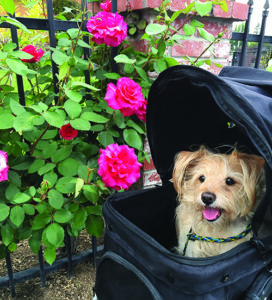
With the change in diet and gentle exercise, Kissy has lost 4 pounds in six weeks; this has improved her health and her future and her world has blossomed. DARP will continue to provide the care she needs until she is placed in a permanent home. For updates about Kissy, visit DARP’s Facebook page: facebook.com/DogwoodAnimalRescue/. As we go to press, CARP is accepting applications for Kissy’s adoption. To apply, or to support DARP’s mission (rescue, rehoming, spay/neuter, education), see dogwoodanimalrescue.org.
DOG WEIGHT LOSS: GO SLOW
Canine weight loss programs can be long-term projects and healthy weight maintenance is lifelong. While the length of time it takes a dog to return to an ideal body weight varies, don’t be surprised if it takes nine months or more to reach that goal. Focus on incremental successes, such as an improvement in BCS or reduction of a health problem.
Keep in mind, too, that it doesn’t take a lot of weight loss to make a dog feel better. Even modest losses can be of benefit. A 2010 study found that there were discernable improvements in the mobility of obese dogs with concurrent arthritis after just a 6% weight loss.
A position paper published by the University of California-Davis School of Veterinary Medicine (“Nutritional Management of Weight”) recommends that dogs lose no more than 2% of their body weight per week. If the loss rate exceeds this, dogs may feel hungry and engage in food-seeking behaviors. Worse, their metabolism may slow (which makes weight loss more difficult) and muscle mass may be lost as the body burns muscle tissue for energy instead of body fat. After beginning a weight-loss program, periodic rechecks and weigh-ins are necessary to ensure that the approach is working and continues to work; often a plan will require tailoring to maintain optimal efficacy.
YOU HAVE ONE JOB
In 2017, PLOS One published the results of a three-month observational study of weight loss in 926 overweight dogs conducted at 340 veterinary practices in 27 countries. The dogs were fed a commercially available dry or wet weight-loss diet; the amounts fed were determined according to the dog’s estimated ideal weight.
The short duration of the study did not permit most dogs to reach their target weight, but even so, owners reported positive changes including improved activity and quality of life.
But the study also highlighted the problem of owner noncompliance. The success of a weight-loss program depends on owners; maintaining owner compliance often proves to be a challenge for veterinary professionals. In this study, nearly 40% of the owners who enrolled their dogs did not complete the trial, similar to retention rates of other field weight-loss studies.
It is our responsibility to protect our dogs – we all agree on that. So remember: By keeping your dog lean, you are helping to prevent him from developing debilitating diseases and live a longer, healthier, and happier life. Keep that in mind when he’s begging for treats, and give him a carrot! He’ll be the better for it.
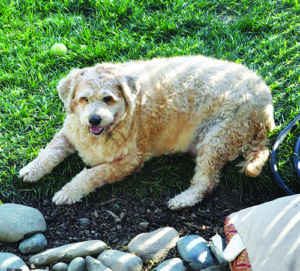
*Dog Food Logic, by Linda P. Case, M.S. Dogwise Publishing, 2014
*Walk a Hound, Lose a Pound: How You & Your Dog Can Lose Weight, Stay Fit, and Have Fun, by Phil Zeltzman and Rebecca A. Johnson. Purdue University Press, 2011
*American College of Veterinary Nutrition
acvn.org/frequently-asked-questions/#Overweight
*Association for Pet Obesity Prevention (APOP)
petobesityprevention.org
*The Global Pet Obesity Initiative Position Statement
petobesityprevention.org/about/#GPOI
*UC Davis Veterinary Medicine, Small Animal Nutrition
vetmed.ucdavis.edu/hospital/animal-health-topics/weight
*World Small Animal Veterinary Association Global
Nutrition Committee
wsava.org/committees/global-nutrition-committee/


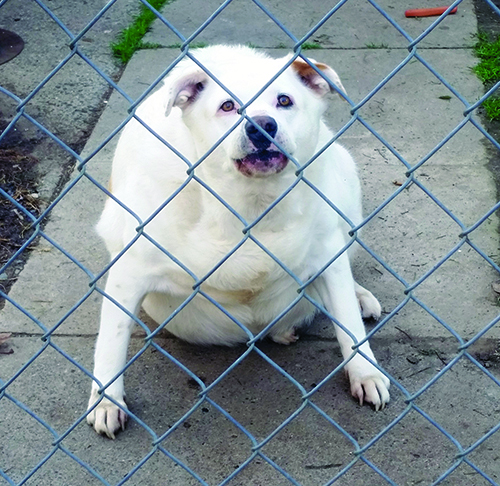




This was very informative, I didn’t know most of what you wrote about.
Very informative post. It enlightened me! Thanks